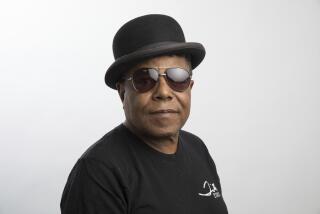X Marked L.A. as the Hot Spot
Imagine rock of the ‘80s without Los Angeles.
No Guns N’ Roses to lead a generation into hard-rock nirvana. No X to galvanize an underground community. No Los Lobos to enrich the roots with Mexican strains. No Phranc to give voice to the persecuted. No Rotondi to reveal the potential of the polka. No Top Jimmy to reprocess the blues through his Falstaffian frame. No Busboys and Fishbone to break racial/musical stereotypes. No Black Flag rage, Wall of Voodoo irony, Peter Case idealism, Minutemen inspiration, Go-Go’s buoyancy, 45 Grave Grand Guignol, N.W.A ghetto blasts.
Los Angeles clearly outdistanced rivals New York and London as a hotbed of musical invention in the years following the late-’70s punk/new-wave eruption, extending and fulfilling the promise of that Big Bang as no other rock center did. Even when the circuit lost some of its steam in the second half of the decade, there has hardly been a time during the ‘80s when you could turn around without bumping into stars-to-be and visionary artists.
A grass-roots scene that began as a scrappy alternative to institutionalized rock was suddenly producing some of pop music’s most creative, individual acts that drew both critical recognition and mass audiences.
X was long the defining, centering force, and its tumultuous saga, especially its uneasy dance with the record industry, was fascinating, inspiring and instructive.
The quartet never made the commercial breakthrough, but it paved much of the way. As the flagship band of the independent Slash label (which sprang from a punk fanzine), X was a key element in the small company’s eventual affiliation with the major Warner Bros. Records, which doesn’t enter into such distribution deals so it can sleep better at night. X itself tested its fortunes elsewhere, while Slash/Warners issued essential records from the Blasters and Los Lobos.
The whole roots-rock-plus-art branch that X represented would later broaden its horizons and yield such bands as Green on Red, the Dream Syndicate, the Long Ryders, House of Freaks and Leaving Trains. Cowpunk was a close cousin, embracing everyone from future country star Dwight Yoakam to Lone Justice and Maria McKee to the Screamin’ Sirens and Rosie Flores.
The Go-Go’s started as a feisty, amateur-hour endeavor and ended up at the top of the national charts. They also made the world safe for all-girl bands, and the Bangles repeated their success pattern. Today, the Pandoras and the Lovedolls and the Tearjerkers continue the tradition.
Berlin and Oingo Boingo also became big “new wave” stars, but no L.A. scene made the commercial splash of the metal division. There was an endless succession of bands that looked ridiculous when they sent out their home-made press kits. Then they were signed by major labels and sold a ton of records: Quiet Riot, Motley Crue, Poison, Great White.
Penelope Spheeris’ documentary “The Decline of Western Civilization II: The Metal Years” suggested that most of Los Angeles’ hard rockers are dim-witted mercenaries--all the more reason to be grateful that Guns N’ Roses (dim-witted and mercenary, maybe, but also truly in touch with the rock ‘n’ roll spirit) is the one that eclipsed all the rest.
Meanwhile, in another part of town, Los Angeles’ rappers stole the spotlight from New York. Black youths’ answer to punk-rock produced both the engaging silliness of Tone Loc, whose “Wild Thing” single sold an astounding 2 million, and the harrowing street-life documentaries of Ice-T and N.W.A.
These days, the intensity level might be down a bit, but the L.A. rock scene is more diverse than ever, and there is every reason to think that the process will continue to be self-renewing. The main lesson of the ‘80s was to expect the unexpected. Tonight, for instance, the Red Hot Chili Peppers, long regarded as an undisciplined joke, mark the national success of their latest album by headlining the Long Beach Arena. So don’t write off Thelonious Monster yet, and watch out for Jane’s Addiction and Mary’s Danish, and even keep a close ear on those kids in the garage down the street. . . .
More to Read
The biggest entertainment stories
Get our big stories about Hollywood, film, television, music, arts, culture and more right in your inbox as soon as they publish.
You may occasionally receive promotional content from the Los Angeles Times.










